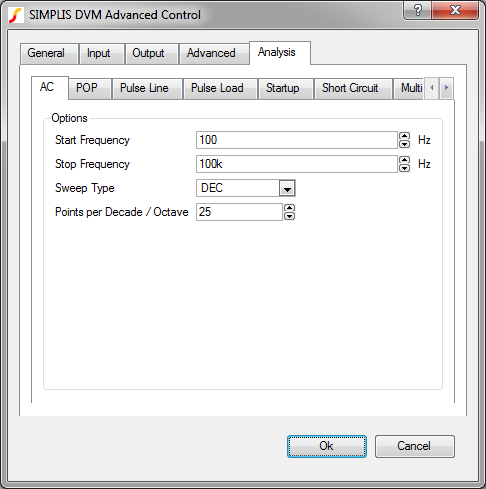DVM - Design Verification Module
|
The purpose of the Impedance() test is to measure either the input or output impedance depending on whether the reference designator is a DVM source or load.
Since the test objective does not specify the input voltage nor the output current, you must provide these values in the Source and Load columns in the testplan.
Both a POP and an AC analysis are used in the Impedance() test.
The POP and AC analysis directives are taken from the POP tab and the AC tab of the Full Power Assist DVM control symbol. The AC tab is shown below.

The test report includes gain, phase, frequency, source, and load graphs as well as the following scalar values which are defined in the Measured Scalar Values section below:
|
|
In this Topic Hide
The Impedance() function has the following syntax with the argument described in the table below:
Impedance(REF)
| Argument | Range | Description |
REF |
n/a |
The actual reference designator of the DVM source or load or the generic syntax of INPUT:n or OUTPUT:n where n is an integer indicating a position in the list of managed DVM sources or loads. |
The Impedance() test objective sets the source and load subcircuits to the following:
| Source | Load |
Loads other than the output under test are set to the Resistive Load. All other sources are set to the DC Input Source.
The Impedance() test objective measures the following scalar values:
Scalar Name |
Description |
Efficiency |
The overall efficiency of the converter taken from the POP simulation |
| Power(LOAD{load_name) | The power of each input source taken from the POP simulation |
| Power(SRC{load_name}) | The power of each output load taken from the POP simulation |
| min_src1_gain | The minimum value for the gain during the AC analysis. |
| max_src1_gain | The maximum value for the gain during the AC analysis. |
| min_src1_gain_freq | The frequency where the gain is at its minimum value |
max_src1_gain_freq |
The frequency where the gain is at its maximum value |
sw_freq |
A number which represents the converter switching frequency |
In the following table, {load_name} is the name assigned to each load. The default value is LOAD. DVM forces each load name to be unique so that the scalar and specification values for each load are unique.
Specification Name |
PASS/FAIL Criteria |
Min_V{load_name} |
The minimum value of the output voltage during the simulation time is greater that the minimum specification value. |
Max_V{load_name} |
The maximum value of the output during the simulation time is less than the maximum specification value. |
The Impedance() test objective is used in several built-in testplans. Shown below are an input and an output test from the DC/DC 1 input/1 output testplan. The managed source and load designators INPUT:1 and OUTPUT:1 are defined in the Full Power Assist DVM control symbol. The tests configures the source to use the Nominal symbolic value from the Input tab and configures the load based on the Light symbolic value from the Output tab. The first test is an input impedance test and the second test is an output impedance test.
| *?@ Analysis | Objective | Source | Load | Label |
| Ac | Impedance(INPUT:1) | SOURCE(INPUT:1, Nominal) | LOAD(OUTPUT:1, Light) | Ac Analysis|Input Impedance|Vin Nominal|Light Load |
| Ac | Impedance(OUTPUT:1) | SOURCE(INPUT:1, Nominal) | LOAD(OUTPUT:1, Light) | Ac Analysis|Output Impedance|Vin Nominal|Light Load |
You can view the complete test report in a new browser window here: Output Impedance Test Report. Below is an interactive link to the same test report.
© 2015 simplistechnologies.com | All Rights Reserved